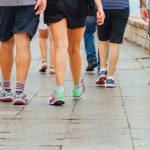ATLANTA—Get arthritis patients moving. That’s the deceptively simple message that ARHP Distinguished Lecturer Leigh Callahan, PhD, associate professor of medicine and social medicine at Thurston Arthritis Research Center at the University of North Carolina at Chapel Hill, delivered in her talk at the 2010 ACR/ARHP Scientific Meeting in November. [Editor’s Note: This session was recorded and is available via ACR SessionSelect at www.rheumatology.org.]
The ARHP Distinguished Lecturer designation is given to someone with long-term experience within rheumatology and rheumatology research. Dr. Callahan has conducted research in physical activity and arthritis, health literacy, and other areas for more than 25 years.
Dr. Callahan’s presentation, “Moving Is the Best Medicine: Outcomes and Insights from Four Clinical Trials,” profiled the primary and secondary outcomes from four clinical trials that tracked arthritis patients who participated in exercise programs. All four programs found that patients had fewer physical symptoms and felt better psychologically after completing their respective program.
Dr. Callahan said that patients know that exercise can help relieve pain, but that does not mean they are exercising. “Sadly, we know the majority of individuals are not meeting recommended levels of physical activity,” she said.
Barriers to exercise that patients face include cost (e.g., the cost of joining a gym), accessibility, finding a safe place to exercise or walk, and weather.
Other patients complain of difficulties in scheduling exercise or feel they have too many other obligations, such as work or caring for children or older parents. Illness, personal or that of a family member, can get in the way of physical activity.
Sometimes, motivation is the biggest barrier, Dr. Callahan said. “Getting people to stop being couch potatoes is hard,” she said.
However, now is a perfect time to push patients to get involved in physical activity, Dr. Callahan said. There is currently a focus on osteoarthritis and the benefits of exercise via the ad campaign from the Arthritis Foundation (AF), ACR, and the Ad Council (go to www.fight arthritispain.org for details) and via the Centers for Disease Control and Prevention’s revised health communications campaign, The Arthritis Pain Reliever.
For anyone who wants to encourage exercise in this patient population group, they should try to recruit well-trained instructors with whom patients can identify.
The Clinical Trials
Dr. Callahan outlined results from four exercise programs that were studied for both primary outcomes, such as physical symptoms, and secondary outcomes, such as depression and self-efficacy. The programs were:
- The AF Exercise Program, which had 346 participants who took part in an eight-week, instructor-led program that emphasized range of motion, gentle strengthening, and endurance;
- Active Living Every Day, which included 354 participants and did not include exercise in the class but emphasized behavioral lifestyle changes during a 20-week period;
- The Walk with Ease walking program, which lasted six weeks and included 462 participants; and
- The AF Tai Chi program, which included 355 participants and lasted for eight weeks.
Investigators conducted a baseline evaluation with participants, a post-program evaluation, and a self-report survey at six months or one year. “We did performance-based assessment, including things like strength, endurance, and balance, and collected those same things post program,” Dr. Callahan said.

